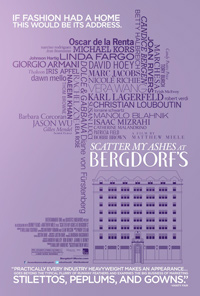Glossy Emptiness; Fashion’s Greatest Church
 The measure of success used in the fashion industry is unlike any used in other commercial art. Rather than massive popularity and accessibility, exclusivity is the name of the game. And exclusive Bergdorf’s Goodman-one of the oldest high-end retailer in New York- is. Matthew Miele’s Scatter My Ashes at Bergdorf’s examines the crucial role of this singular store has had in shaping how America, and the world, experiences fashion.
The measure of success used in the fashion industry is unlike any used in other commercial art. Rather than massive popularity and accessibility, exclusivity is the name of the game. And exclusive Bergdorf’s Goodman-one of the oldest high-end retailer in New York- is. Matthew Miele’s Scatter My Ashes at Bergdorf’s examines the crucial role of this singular store has had in shaping how America, and the world, experiences fashion.
The story of this mythical establishment not only correlates with, but also defines the trends and designers that have set the basis of style for the past century. A parade of personalities, not only from the fashion world but from TV and Film as well, describe their experiences as costumers, admirers, or aspiring designers trying to get their lines inside the exuberant halls that adorn the interior of the building on 5th Avenue. From Joan Rivers to Armani, every celebrity testifies of his or her epiphany at NYC’s church of fashion, which excess leaks even onto the elaborate window displays. Such grandeur, at least as depicted by the film, can certainly leave outsiders wondering what’s the big fuzz. Viewers without a genuine interest in the couture-culture might find themselves lost, as this is not meant to be a universally approachable film. Lots of names are dropped, and its expected of the viewer to know their significance within the context of fashion On the other hand, the niche audience will find an almost biblical guide to the industry within its running time-a 90-minute course on Fashion Marketing 101.
Founded first as a ladies’ tailor shop in 1899 by French immigrant Herman Bergdorf, and then bought by his apprentice Edwin Goodman, their emporium has becomes the Mecca of innovation, quality, and glamour. Miele provides a detailed overview of the retailer from its most influential woman in charge of acquiring new collections: Linda Fargo, to beloved witty sells associate “Betty”. There are relatable moments, even comedic relief in the overcrowded array of talking heads, but the film is irremediably self-indulgent. It bestows an outrageous sense of importance on superficiality.
Yes, this business thrives on the flamboyantly expensive, but to say those that whoever can’t afford $6,000 shoes should aspire to shop at Bergdorf’s is just offensively pretentious, even insensitive. But for a film that emphasizes the desire of using a department store as posthumous mausoleum it seems down right fitting.
In the world of high fashion, Bergdorf’s is synonymous with guaranteed success in the most spectacular manner. There is such devotion into the launching of a brand within its walls, that some dare to say, “if your line is not in Bergdorf’s, you have no future”. As a self-contained factory of dreams this place is a wonderful crown jewel for consumerism, but is far from being a mirror of reality. Scatter My Ashes at Bergdorf’s most memorable sequences showcase the intricate design that goes into the exquisite window displays. Those artificially sculpted scenes summarize the feeling one gets about the store and the film-entrancing to look out from the outside, yet intangible for the mortal hands of the masses.


